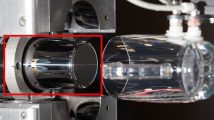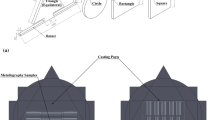Abstract
Working materials for mold sets used in slip casting technology are reviewed. Benefits and shortcomings of the materials are discussed and routes towards improving their performance are suggested.
Similar content being viewed by others
References
A. G. Dobrovol’skii, Slip Casting [in Russian], Metallurgiya, Moscow (1974).
A. G. Romashin, E. I. Suzdal’tsev, and M. Yu. Rusin, “Fabrication of large-sized complex-shaped components from quartz ceramics: research and practical aspects,” Novye Ogneupory, No. 9, 34–40; No. 11, 20–27 (2004).
E. I. Suzdal’tsev, “Molding techniques using high-density aqueous suspensions of lithium aluminosilicate glasses,” Ogneup. Tekhn. Keram., No. 11, 10–23 (2002).
E. I. Suzdal’tsev and V. I. Kurakin, “A theoretical and computational model for the buildup of the wall thickness of a ceramic molding layer cast from an aqueous slip into a porous mold,” Ogneup. Tekhn. Keram., No. 10, 8–12 (2001).
E. I. Suzdal’tsev, “Fabrication of high-density quartz ceramics: research and practical aspects. Part 2._Shaping methods,” Novye Ogneupory, No. 9. 26–35 (2005).
E. I. Suzdal’tsev, “Technology and manufacture of lithium aluminosilicate glass ceramics. A statistical analysis,” Ogneup. Tekhn. Keram., No. 3, 12–18 (2004).
V. V. Platonov and M. Yu. Rusin, “A device for molding ceramic components using aqueous slips. RF Patent No. 2123928,” Byull. Otkr. Izobr., No. 36 (1998).
Yu. E. Pivinskii and A. G. Romashin, Quartz Ceramics [in Russian], Metallurgiya, Moscow (1974).
E. I. Suzdal’tsev and A. A. Efimova, “The effect of the form material and the method of forming on sintering and vitrification of quartz ceramics,” Neorg. Mater., 16(7), 1255–1258 (1980).
E. I. Suzdal’tsev, “Properties of quartz ceramics,” Neorg. Mater., 16(2), 330–335 (1984).
K. K. Tikhanovich and N. N. Teptyuk, “A material for molds used in ceramics industry, USSR Inventor’s Certiticate No. 554241,” Byull. Otkr. Izobr., No. 14 (as of May 3, 1974).
Yu. E. Pivinskii, P. P. Mityakin, V. A. Bevz, and N. N. Teptyuk, “A composite for casting molds, USSR Inventor’s Certiticate No. 806632,” Byull. Otkr. Izobr., No. 7 (as of February 23, 1981).
M. A. Akhmedov, K. É. Sarkisyan, P. F. Gordoneevskii, et al., “A mixture for plaster molds, USSR Inventor’s Certiticate No. 543635,” Byull. Otkr. Izobr., No. 33 (as of May 17, 1977).
S. A. Novikov, V. M. Shorokhov, V. D. Boguslavskii, “A composite for plaster molds, USSR Inventor’s Certiticate No. 789453,” Byull. Otkr. Izobr., No. 47 (as of December 23, 1980).
E. I. Suzdal’tsev, T. P. Kamenskaya, M. A. Suslova, et al., “An optimized technology for molding large-sized complex-shaped preforms from lithium aluminosilicate slips,” Ogneup. Tekhn. Keram., No. 5, 25–31 (2004).
Author information
Authors and Affiliations
Additional information
__________
Translated from Novye Ogneupory, No. 3, pp. 47–52, March, 2006.
Rights and permissions
About this article
Cite this article
Suzdal’tsev, E.I., Kharitonov, D.V., Dmitriev, A.V. et al. Improving mold sets for large-sized components prepared from aqueous slips. Part 1. Working material for the mold set. Refract Ind Ceram 47, 116–120 (2006). https://doi.org/10.1007/s11148-006-0068-z
Received:
Issue Date:
DOI: https://doi.org/10.1007/s11148-006-0068-z




